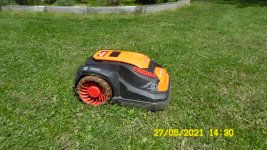As I didn't get reliable and repeatable results with the actual setup and because I get noticed about OpenMower project, I started to combine OpenMower project (which also relies on ROS) with my ROSMower. I like the way they implemented the behavior of the robot and also the way they do the path coverage. As they use a dedicated commercial mower, I had to build some wrappers to incorporate my hardware.
Also I payed for the expensive way of RTK-GPS. I really tried without and I had some success, but it is not accurate enough in my opinion.
Now my house is equipped with RTK base station and my rover with rtk solution as well. Both communicates by wifi. So if you're interested in the least expensive RTK solution, purchase two Ardusimple RTK board with ublox patch antenna directly at ardusimple.com. Inclusive tax and shipment, you still have to pay up to 450€. I don't use any radios, instead I use wifi of rover and used an old raspberry pi for base station.
After long fighting with myself, I paid for it. But don't believe my problems has been solved. It is still not a plug and play solution. I had to tweak the settings to get a good and reliable signal. Also it is not that easy to find a proper antenna placement on rover. Space is limited, you know, and you have good luck to pick up reflecting signals, electronic noise and others.
After first frustrating tests, I started some semi-scientific test this week and want to share my results with you. Maybe it is helpful for some of you.
Website about HowerMower, a lawn mower based on Hoverboard Hardware

hovermower.github.io
If you're lazy and don't want to read all this stuff there, the best candidate seems to be a small, round steel can of 120mm diameter, 60mm height. Turn it around and place antenna on top of it.
Next step is to build a mount for antenna, check base station again to get a reliable GPS fix.



